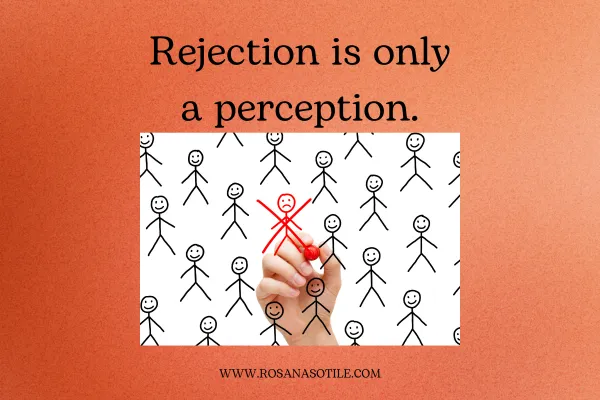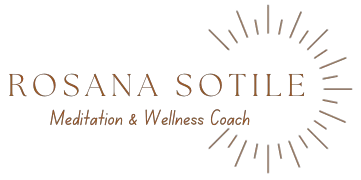Articles of Knowledge

Rejection is only a perception
By: Rosana Sotile, Chopra Certified Well-Being Coach
"Success is not final, failure is not fatal: It is the courage to continue that counts."
- Winston Churchill
At some point in our lives, we all experience rejection. Whether it’s rejection from a romantic partner, a job application or a more subtle experience of trying our best and failing, it still hurts. What most people don’t realize, though, is that there are different types of rejection. On average, the human mind-body system will experience external rejection, internal rejection and universal rejection. So, let’s take a look at each one.
External Rejection
Simply put, external rejection comes from sources outside of our internal world. From a psychological standpoint, rejection isn’t an actual “thing” that happens. It’s a perception. The partner that left you did just that- they physically exited the relationship. But your mind and heart perceived it to be rejection. The ego-mind attaches its suffering to a source outside of itself, because it feels good to assign the root cause of suffering to something else or someone else.
Most people remain in this state of reference, which is also known as object referral. We are conditioned at a young age to look for approval outside of ourselves, such as seeking acknowledgment from parents or teachers. As we grow older, we condition ourselves further to believe we must find love from others to make us worthy, or achieve that promotion at work to advance in social status.
We spend our entire lives referring to people, objects and experiences to make us happy. And when they don’t, we feel rejection. Which takes us to the next state of rejection:
Internal Rejection
This type of rejection is a bit more nuanced, and although many people suffer from it, it is not easily recognized or understood. So, let me give you an example. Let’s say you are single and dating, and you meet someone who checks all of the boxes of your “dream partner”. You begin to grow close, sharing vulnerable and intimate moments, and eventually, you realize that the connection has potential to be something meaningful and dare I say, “real love.” But as soon as you make this realization, your mind begins to remind you of your past experiences with love and the grief it caused you. So you bring these experiences up to your partner to explain to them that you aren’t able to proceed with the connection because it’s too much.
Your partner then goes through their own process of external rejection, while you subconsciously reject your true self. Blinded by your attachment to your past experiences, you project false patterns onto your present situation, blocking your heart from receiving what it truly desires.
Unprocessed trauma can cause a person to reject what is good for them, because they would rather feel safe in the dysfunction of their mind. Yes, it’s true, some people take comfort in pain and suffering, especially once they establish limiting beliefs and conditioned thought patterns. Remember, most of these beliefs and patterns are formed at a young age, either in childhood or young adulthood. And it feels safe to keep your mind, heart and energy tucked away in the fear blanket, because it prevents you from getting hurt again. If you don’t take the risk of loving someone again, then you won’t make yourself vulnerable to pain again, right?
Sure, we might fail if we take another risk, but we also might receive something incredible and life-fulfilling. And that brings us to examine the third state of experiencing rejection:
Universal Rejection
Have you ever thought to yourself, or heard someone say out loud, “Why does God hate me so much,” or “The universe just isn’t on my side”? When we experience a string of bad events, we often attribute it to having bad luck or being the victim of some sinister plan from a higher power. Similar to the object-referral perception of rejection, we seek to blame our spiritual source of our suffering.
When we tap into a higher source for validation of rejection, we’re only rejecting our true self.
Our true self is the part of us that exists beyond our bodies and minds, and outside of the constructs of space and time. Our true self is our soul, or consciousness. And it exists infinitely, without any conditioning or limits, and where any possibility is capable of manifesting.
In reality, there is no such thing as “divine rejection”, because the source of all creation is also the source of unity. When we grasp the attributes of unity, it becomes impossible to reject anything. Instead, we graciously accept each experience in life for what it is. Any perceived rejection becomes an opportunity for us to look into the proverbial mirror of our inner world, where we most likely will find those conditioned beliefs and mental patterns blocking us from accepting ourselves just the way we are.
How to navigate the stages of rejection
The most important aspect of healing from rejection is awareness. Become aware of your feelings and emotions, and especially how they feel in your body. The majority of chronic physical pain is actually unprocessed emotional pain that becomes manifested. Our bodies store memory within our cells and soft tissue. If we don’t process trauma, we store emotional toxic residue and carry it with us indefinitely.
The easiest way to get started with emotional processing is through self-inquiry. By asking yourself introspective questions, you expand your consciousness and self-awareness, regenerating your connection to your higher self. By understanding, and accepting, your true self on a much deeper level, you build resilience instead of fear.
Here are a few prompts to begin self-inquiry through the 3 types of rejection:
External:
Name the aspects in your life you attach happiness to: your job? Your partner? Your house or car? The next vacation? It’s ok to have these, but it’s more important to be aware of what you’re attached to.
Now, go one by one and imagine if you didn’t have that in your life. How would you feel? Who would you be? What are the ways you could become the sole provider for your own happiness, without anything external?
Internal:
Recall a recent conflict you’ve had with someone. How did you react? In what ways were your responses or actions based on past experiences?
If the outcome of the conflict was not what you desired, what would you have wanted it to look like? What part did you play that prevented your desired outcome? What did it cost you? What can you do next time to break out of any repeating patterns or let go of false beliefs?
Universal:
The fundamental goal for navigating the perception of God rejecting you is to reconnect with your true, infinite self. Sometimes it’s easier to do this with your inner child first.
Picture a young child standing in front of you, around 6 or 7 years old. Perhaps it’s you at that age, or one of your own children at that age, or a niece or nephew. Now look down at that child and say to him or her, “God doesn’t love you. You are not worthy of unconditional divine love.”
What does it feel like to say that to an innocent child? What would it feel like to say that to yourself at that age? What would your higher self say if you said that your inner child? Is what you said true? Is it, really?
As you continue to reflect on your inner child and reconnect with your true self, you can also begin to incorporate the concept of “if not this, then something better.” Repeating this phrase to yourself when you face rejection restores your faith that the universe, or God, has nothing but good intentions for you. It’s our ego-mind that attempts to sabotage our gratitude and positivity. But when we navigate our struggles with trust and faith that something better is coming, we are able to rewire our minds and undo all of the conditioning that holds us back.
If you still struggle with letting go of rejection, other healing modalities may be useful to take you further inward, such as meditation, somatic coaching, talk therapy, or spiritual counseling.
You can also find more information on meditation instruction and personalized coaching at www.rosanasotile.com
Sign up for my free weekly newsletter and get a 5-minute guided meditation!

Rosana Sotile is the founder of Sacred Space Health, LLC and holds certifications as a Well-Being Coach, Primordial Sound Meditation Instructor, and an Ayurveda Health Instructor from the Institute for Integrative Nutrition and Chopra Education. She has a passion for helping people discover their inner sacred space and embrace the power of manifesting new realities. She also enjoys spending her free time in nature, especially at home in South Louisiana with her four children and one cat.
Rosana can be reached at info@rosanasotile.com, or direct message on LinkedIn

